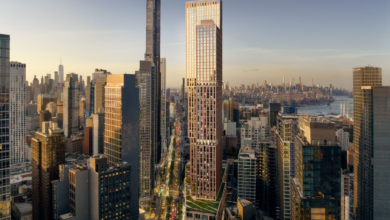Vanbarton’s Office-to-Residential Conversion Play


“We’re swinging hammers!” Richard Coles likes to brag.
That bit of developer-speak is his way of saying that while seemingly everyone is talking about converting outdated office buildings into apartments, his company Vanbarton Group is actually doing it.
Dressed in his gray suit and yellow construction hat, Coles tours his hollowed-out office building in Lower Manhattan, showing off his work. The space is only vaguely recognizable as a former workplace, as the skeleton of apartment walls fills in the wide-open floorplate.
But about an hour into the tour, Coles hasn’t literally swung anything. When this is pointed out, the bravado becomes real. He reaches for the nearest tool, a bulky power saw, and excitedly waves it around in the air, miming some demolition work.
The whole scene is a bit of self-conscious silliness, but he’s made his point: Vanbarton is doing what others are only talking about.
The company, which Coles launched a decade ago with his partner Gary Tischler, has in short order become one of the busiest converters in New York.
They’ve jumped at the chance to snap up discounted office towers and turn them into apartments for the kind of profits that have everyone talking about rolling up their sleeves in the first place.
Vanbarton has five conversion projects in Manhattan with more than 2,200 units in the pipeline and doesn’t appear to be slowing down. The firm recently picked up its first project outside New York, in Seattle.
But the window of opportunity may be small. Conversions are perilously tricky to pull off, and they only really work if buildings can be had at a low enough price. The clock is also ticking: the main tax incentive for developers gets smaller the later a project gets started, so the most lucrative benefits won’t be available long.
The biggest challenge is competition. Any building that’s a conversion candidate draws all the other developers out there scouring Manhattan, which means Coles will have to do more than swing hammers to take the conversion crown.
Sweet spot
Lower Manhattan’s Water Street is the heart of what’s known as the Insurance District — a canyon of boxy office towers with about as much pizzazz as the industry the area’s named for.
But it’s down here that some of the prime candidates for residential conversion cluster.
When Vanbarton’s conversion at 160 Water Street opened its doors in late 2023, the 588-unit apartment building was the largest project of its kind to come online in the post-pandemic hybrid-work era that had hurt so many of New York’s office buildings.
Coles and Tischler acquired the 1970s-era building in 2013, about the time they bought the property next door at 180 Water Street. They turned 180 Water into 573 apartments, but when it came to 160, the developers went back and forth on the right strategy.
They put the building up for sale, eyeing a price tag of $240 million in 2021, when the city was still dealing with the fallout from the pandemic. But as renters started to return and the residential market rebounded, the duo pivoted and took the building off the market, deciding to move forward with the conversion.
“They are certainly quick studies. They snapped up a couple of great assets that they’re in the process of developing. I think they will do very very well.”
Coles said the price they paid for the building — $165 million — helped the project pencil out without subsidies.
“I think [the] cost basis of our investment, which we purchased back in 2013, enabled us to be able to do it without incentives,” he said at a press conference in March 2023, when Mayor Eric Adams toured the building.
While finishing up the project, Vanbarton lined up new ones.
The company signed a deal in September 2024 to buy the nearby 77 Water Street for $95 million and turn it into 600 apartments. Just a few weeks later, in October it struck again with an agreement to buy the offices of the Archdiocese of New York at 1011 First Avenue in Midtown for $103 million — another 420 future units.
Coles and Tischler made a decision the following month to create 100 apartments on three floors of offices at a building they own at 980 Sixth Avenue that were left vacant when WeWork went bankrupt.
And in May of this year, the developers signed a contract to pay the Milstein family’s Emigrant Savings Bank $140 million for the Midtown office building at 6 East 43rd Street, which Vanbarton will transform into more than 500 apartments.
When done properly, conversions can generate risk-adjusted returns that are more attractive compared to conventional construction. The total project cost is usually lower and apartments can come online and start earning rent in a little more than a year, compared to three years or more for traditional ground-up projects.
Vanbarton, like most other converters, will look to sell its projects once they’re completed. Coles said that rather than taking on mega-projects of 1,000 units or more, the company’s strategy is to target buildings in the 500-to-700-unit range.
“We find the exit liquidity at that scale is a little bit more robust,” he said at The Real Deal’s New York forum development panel in May.
Spinoff
The company that would become Vanbarton Group got its start some 30 years ago when Coles and Tischler worked at a development firm called Emmes Group of Companies.
Emmes was a big buyer of distressed real estate in the 1990s. Tischler joined the company in 1994 as general counsel and Coles, who had started his career at Goldman Sachs, came on board as an associate in 1997. They complemented each other.
“They both had experience in workout -and-turnaround situations,” said Andrew Davidoff, Emmes’ CEO. “Richard spent the majority of his time with us working on quite difficult turnaround projects. Gary was trained as a lawyer before he joined Emmes. He’s a very experienced negotiator, knows how to structure transactions.”
But at some point the partners started to differ on the company’s strategy, and in 2015 Coles and Tischler spun Vanbarton Group out of Emmes. The name is a portmanteau of Vanderbilt, the Graybar Building, which is where Emmes had its offices, and Lexington.
Coles and Tischler kept the registered investment advisory part of the business, which allows them to raise money from large pension funds. Vanbarton has a long track record of working with institutions like the Ohio Public Employees Retirement System and the Michigan Office of Retirement Services.
It’s also tapped into new pockets of capital. On at least three conversion projects, it paired up with AVRS Partners, a company founded in 2023 by the Brazilian banking scion Edward M. Safra and Adnane Mousannif, former head of real estate for the Americas at the Qatar Investment Authority. Gila Cohen, Vanbarton’s chief executive officer, had worked with the principals earlier in her career.
“I have to believe it’s a cyclical industry and the numbers will ebb at some point. But there is still a tale of two cities where there is a big part of the office inventory in our city — and cities around the country — that is structurally obsolete. I think there’s going to be another four to seven years of that opportunity set.”
Following the spinoff from Emmes, Coles and Tischler aggressively amassed a portfolio of office buildings, hotels, retail properties and apartments, establishing themselves as major players.
In 2015 alone, they bought the office building at 31 Penn Plaza for $265 million, the Riverdale Crossing shopping center in the Bronx for $133 million, an office at 45 West 45th Street for $81 million and an office building in San Francisco at 301 Howard Street for $200 million.
The next year was busy as well. Vanbarton picked up the office building at 292 Madison Avenue for $180 million and two office buildings in San Francisco: 100 Montgomery Street for $285 million and 115 Sansome Street for $83 million.
They made their biggest office investment in 2018, buying 425 Lexington Avenue in New York for $700 milliion and followed that up the next year with a $305 million deal for an office building in Seattle at 901 Fifth Avenue.
Master class
You can’t talk about conversions without talking about Nathan Berman.
Nicknamed “The King of FiDi,” Berman made a name for himself converting Lower Manhattan office buildings in the late 1990s and early 2000s, mastering the art of jigsaw-puzzle floorplates and tax-incentive programs.
He seemed to be quiet for a bit in the 2010s, when everyone was pumping money into office buildings to make them flashy workplaces, not places to live. But when the trend reversed, he was back.
Berman’s Metro Loft is now working on the biggest conversions in the city, including the 1,300-unit 25 Water Street and the 1,500-unit 111 Wall Street. He is heading the largest project of this kind in history: the 1,600-unit conversion of the former Pfizer headquarters in Midtown, on East 42nd Street.
Coles and Tischler got their first exposure to the business by lending to Berman. They eventually brought him on as their builder when they decided to convert the aforementioned 180 Water Street, and from Berman they learned the finer points of this niche.
“They are certainly quick studies,” said Berman, who bought 180 Water from Vanbarton in 2017 for $450 million. “They snapped up a couple of great assets that they’re in the process of developing. I think they will do very very well.”
Coles and Tischler picked up one important trade secret from Berman.
To oversee their conversions, they hire Collaborative Construction Management, the project management firm that does all of Berman’s work.
“In fact, that’s how we came to know Vanbarton, because they were [Berman’s] development partner at 180 Water Street,” said Michael Siciliani, CCM’s CEO.
Siciliani said he’s done every Metro Loft conversion since 1997, and that Vanbarton has put together the infrastructure to be similarly successful.
“They developed a strong internal management team that can process all the decisions that are necessary and keep the ball rolling,” he said.
Getting crowded
Aside from Metro Loft and Vanbarton, a number of other firms are looking to convert buildings. SL Green last month filed plans to convert an office building it owns at 750 Third Avenue into 780 apartments, and is partnering with Scott Rechler’s RXR to transform 5 Times Square into 1,250 rental units.
RXR has also mulled the idea of turning part of the Helmsley building at 230 Park Avenue into apartments.
Others are building up war chests for when opportunities arise. Last year, TF Cornerstone and Dune Real Estate created a $1 billion venture targeting conversions in cities like New York, Boston and San Francisco. Earlier this year Don Peebles and former Carlyle Group partner Doug McNeely announced plans to raise a $1.5 billion conversion fund.
And there’s motivation to get moving quickly.
Last year the state created the 467m tax incentive, which offers converters tax abatements for up to 35 years, in exchange for setting aside at least 25 percent of a project’s apartments as income restricted.
But in order to get the full 35-year benefit, developers need to have their plans in place by June of 2026. After that, the term drops down to 30 years and then down to 25 years for projects that start after June 2028.
Coles acknowledged the closing window but said he still sees a big opportunity in the next few years.
“I have to believe it’s a cyclical industry and the numbers will ebb at some point. But there is still a tale of two cities where there is a big part of the office inventory in our city — and cities around the country — that is structurally obsolete,” he said. “I think there’s going to be another four to seven years of that opportunity set.”

